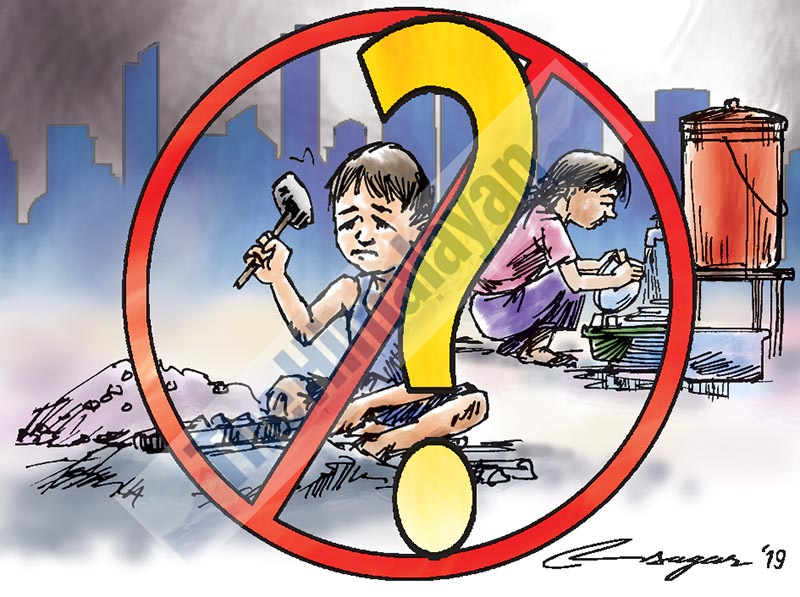Ending child labour: Whose concern is it?
Investing in strategies that work will benefit all of us, not just children. It’s high time the government adopted a stronger approach to ending child labour. Child labour should not just be limited to protecting children from exploitation
Child labour is widespread in Nepal, and one that has not declined despite the laws that prohibit it and the constant efforts of many governmental, non‐governmental and international organisations to protect children’s rights.
While travelling within the city, you go to office in a micro-bus with a child conductor; you go to the canteen for lunch with a child waiter serving you water and cleaning the table; you go to a shop to buy fish where an 11-year-old boy cleans the fish for you. The rag pickers moving around in your locality are usually children under 15 years.
You are invited to a friend’s house for dinner, they have school-going children as domestic help.
The causes of child labour are many. From poverty to abandoned children to orphans to children chasing city dreams, all those innocent little ones end up in a place where they do not belong.
One major concern has been the hazardous environment in which children work, but another big concern is their commercial sexual abuse, certainly one of the most brutal forms of violence against children.
Though prostitution is illegal in Nepal, it is prevalent in the urban areas, and many young girls are trafficked to for commercial sex work within the country and in India.
Government and civil societies have not remained silent, yet the issue has not been owned, rather remains as a project for NGOs and a matter of pride for the government to have formulated the law. Who is responsible for ensuring its implementation? Some days back, while I was walking from Jamal toward Ratna Park, I saw a girl of 12-13 years in red pajamas and a school jacket begging in the street in the early morning. She looked scared and pale. So I approached her to ask where she lived. She said that her mother was sick and that they lived in Swayambhu, a 20-minute drive from Jamal.
I told her that I would be willing to help her go to school, but she did not answer.
I reported this on hotline 104, but they took it lightly - probably because begging children are everywhere in Kathmandu. I did make follow-up calls for three consecutive days, but got no information. We are not sensitive, neither we the common people nor the government.
The ILO estimates that 21 million people are victims of forced labour around the world, generating approximately US$150 billion a year in illicit profits. Forced labour takes different forms, from forced sexual exploitation to debt bondage or event trafficking in persons and slavery. The victims are exploited in agriculture, domestic work, construction, manufacturing, mining and other economic activities. Women and girls, in particular, are subjected to commercial sexual exploitation.
Between 2000 and 2012, governments made impressive strides in reducing child labour. During that period, child labour rates dropped by one-third – to 168 million from 250 million.
This meant 70 million fewer children were toiling at young age or in hazardous work. But from 2012 to 2016, the number of children in child labour dipped to 152 million from 168 million, only one-third of the reduction achieved in the previous four years. At this rate, governments have no hope of meeting the target they set in 2015 to end child labour by 2025 as part of the Sustainable Development Goals.
A number of laws contain important provisions for the protection of the interests of children and child labourers. Employing children in dangerous work or against their will is punishable by up to one year in prison. Children are prohibited from being involved in the sale, distribution or trafficking of alcohol or drugs.
The government has also ratified ILO Conventions 138 and 182, as well as other relevant conventions, which specify the minimum age for admission to work and employment or putting an end to the worst forms of child labour. However, such legislation alone will not be sufficient to address the complexities of child labour in Nepal.
Social welfare policies related to children are just as crucial. They are necessary to address the underlying causes of child labour. Second is to ensure law enforcement through effective inspection and penalty for those who exploit children.
Where there is a strong legal framework (both in paper and practice), child labour is less likely to flourish. Third, addressing the root causes of poverty and school dropout, to name a few, would stop children from entering the labour force.
Providing poor families with a guaranteed monthly income and school meals will relieve them of the financial pressure that has been contributing to child labour.
The Prime Minister Employment Programme (PMEP), launched in February this year, is expected to lessen the burden, however its effective implementation is a big question like any other programme or campaign of the government.
The Human Rights Watch 2017 report notes that Morocco was able to reduce child labour rates by one third by paying just US$7 a month per child to a family.
Investing in strategies that work will benefit all of us, not just children. It’s high time the government adopted a stronger approach to ending child labour.
Child labour should not just be limited to protecting children from exploitation, which is generally the practice.
Only by interrupting cycles of poverty by strengthening families, communities and economies will child labour end.






